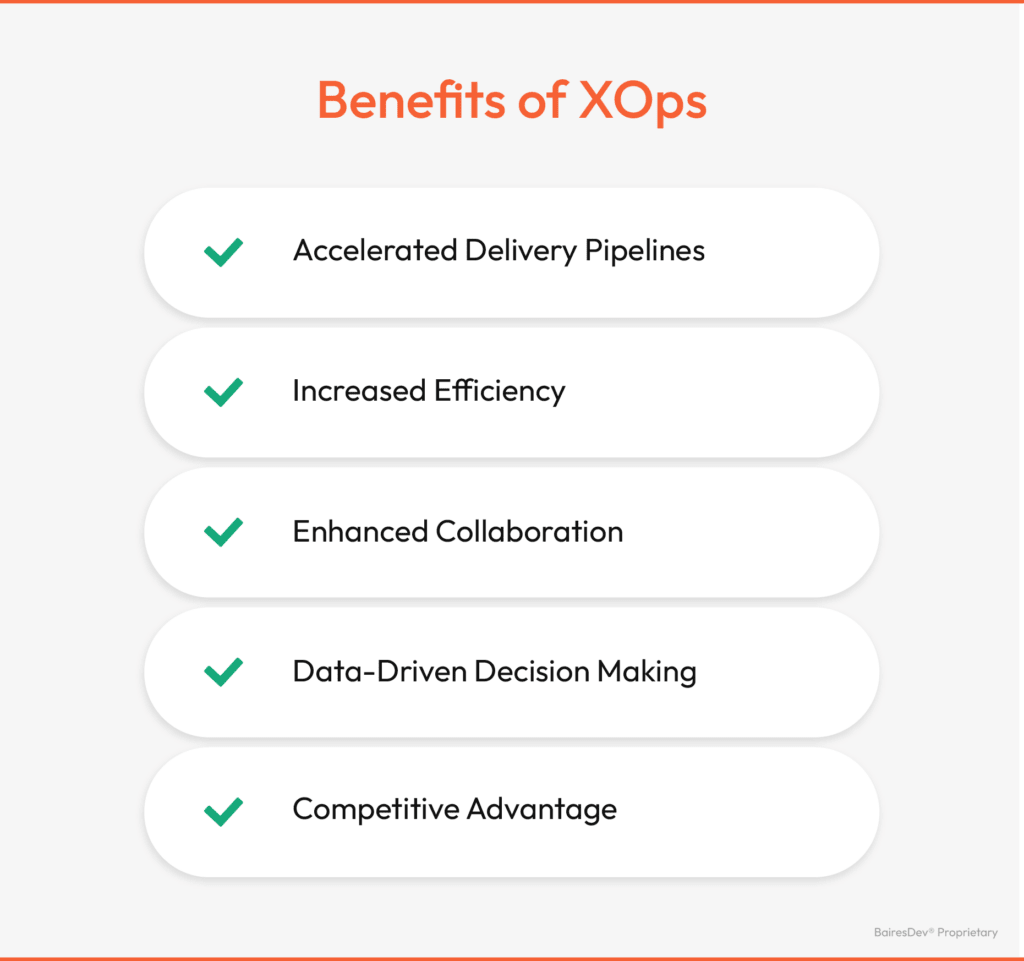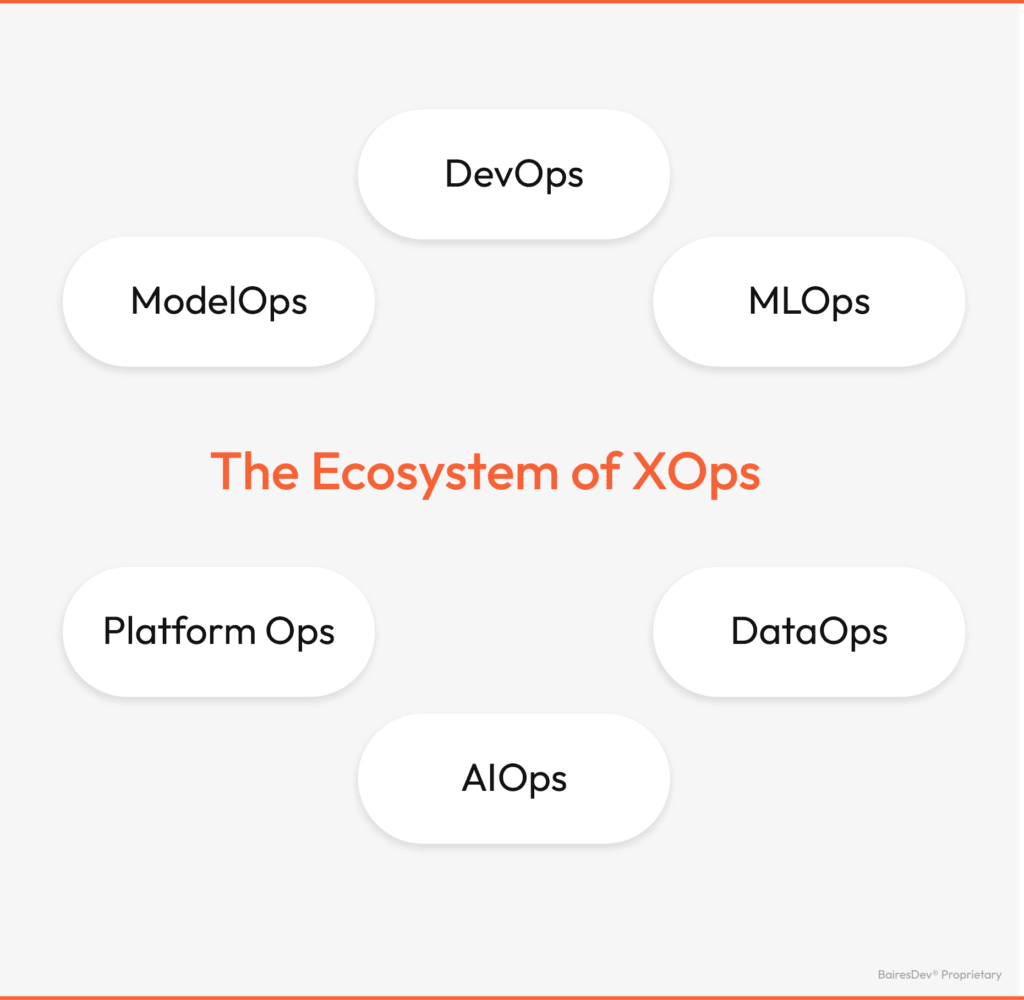DevOps helped organizations innovate faster—XOps is now helping them operate smarter. DevOps revolutionized how organizations innovate, but as systems grow more complex, many tech leaders are hitting roadblocks. Multi-cloud environments, siloed teams, and the demand for real-time insights are creating inefficiencies, delays, and security gaps. These challenges are no longer about speed alone—they require smarter, more integrated operations.
That’s where XOps comes in. By combining DevOps with frameworks like SecOps, DataOps, and AIOps, XOps unifies workflows, tackles complexity, and helps businesses address their most pressing operational pain points. It’s not just about keeping systems running—it’s about making them secure, scalable, and efficient.
With AI-driven tools and enhanced collaboration, XOps solves problems before they escalate, improves software security, and streamlines operations. For tech leaders facing mounting pressure to deliver more with less, XOps offers a path to stay ahead in today’s fast-paced industry.
The Big Wins You Get with XOps
XOps takes a fresh approach to how we work, making it easier to be organized, spark innovation, and create improved customer experiences. Let’s look at some of its benefits.

Speed and Flexibility
By breaking down silos, XOps speeds up workflows, automates repetitive tasks, and helps teams adapt to changing market demands.
Innovation and Results
Close collaboration fosters creative problem-solving and better software quality, ensuring your team stays ahead of the curve.
Smarter, Unified Decision-Making
With integrated tools and aligned goals, XOps accelerates decision-making, reduces miscommunication, and streamlines operations for faster, more effective outcomes.
Scalability and Adaptability
XOps enhances efficiency and coordination, making it easier to scale operations and adjust to evolving business goals.
Customer-Centric Solutions
Teams like data science and customer analytics work together to deliver insights that create solutions tailored to customer needs, improving experiences and competitiveness.
XOps: Where Integration Meets Innovation
DevOps has been shaping software delivery since its inception in 2009, revolutionizing how teams collaborate and innovate. But as projects got more challenging, we realized it wasn’t enough. That’s where all the ‘Ops’ frameworks like DevSecOps, DataOps, and MLOps came in, each solving specific issues. Now, XOps ties it all together, creating one unified approach instead of having these separate silos.

It might sound like just another buzzword, but XOps isn’t about adding complexity—it’s about simplifying things. It gets your team on the same page, using shared tools and workflows. The payoff? Quicker updates, fewer bottlenecks, and superior collaboration.
A Real-World Look at XOps
Let’s say there’s a logistics company gearing up for the holiday season—a time when shipments skyrocket, customer demands go through the roof, and inventory challenges pile up. With XOps, team members work together to handle it all. Here’s how:
- DevOps: The development and operations staff team up to create a real-time shipment tracking feature on the platform. Automated pipelines make sure updates launch quickly, even during the busiest times.
- DataOps: Data teams work with machine learning engineers and developers to create predictive analytics tools. These tools spot issues like low inventory levels or high-demand areas.
- AIOps: AI-driven monitoring keeps an eye on warehouse operations, flagging anomalies like slower processing times. These systems alert the operations team and even suggest fixes, like redistributing tasks or automating workflows.
- SecOps: Security teams work hand-in-hand with DevOps to protect customer and supplier data. They help developers weave security checks right into the development process to keep vulnerabilities in check.
By bringing all these roles together, XOps keeps customers in the loop with accurate updates and implements systems that can handle holiday pressures without a hitch. It’s a smarter way to navigate the chaos—leaving siloed teams in the dust.
Breaking Down Silos: How XOps Enhances Collaboration
In a typical setup where teams work in silos, there’s often a lot of disconnect. One team might not know what the others are doing, which can lead to delays, duplicated efforts, and missed opportunities. That’s where XOps comes in—it brings everyone together to work toward a shared goal with clear direction, making collaboration smoother.
Let’s go back to the logistics company example, but this time with a focus on reducing costs across the board. In the old way of doing things, engineering, data science, and operations would all tackle cost-cutting separately, which isn’t exactly the most efficient approach. With XOps, the process starts with everyone sitting down to define clear targets, like cutting warehouse energy use or getting rid of unnecessary system redundancies.
Here’s how it plays out:
- Engineering builds scalable systems, like inventory tracking tools, to improve performance.
- Data science digs into historical data to find patterns in shipping delays or inefficiencies, giving engineering a clear roadmap for what to tackle.
- Operations use that info to negotiate better contracts and sync transportation schedules to cut costs.
Teams are no longer solving pieces of the problem on their own. Instead, they’re working together, making fixes faster, and improving project turnaround times across the board.

4 Steps to Implement XOps
Bringing XOps to your team takes some careful planning. Here’s a simple breakdown to help you get started.
1. Define the Problem and Success Metrics
What’s the specific issue you want XOps to solve? Are you looking to improve customer satisfaction or speed up how fast you deliver projects? Whatever it is, make sure the goals are laid out clearly. For example, if customer satisfaction is the focus, you might aim to cut down the time it takes to resolve customer issues. The key is choosing metrics that tie directly to what you’re trying to achieve so you can measure success.
2. Get the Right People on Board
Build a team that has all the skills needed to tackle the challenge. You’ll want folks from engineering, product, and design working together across specialties. A mix of perspectives makes for unique ideas and collaboration. And if you’re struggling to find the right talent, we can help find the right expertise to fill those gaps with skilled experts.
3. Make a Plan That Works for Everyone
Set up weekly meetings, share collaborative documents or project boards, and make sure everyone’s using the same tools to stay on track. And don’t forget to collect feedback regularly—whether through quick surveys or one-on-one chats—so you can adjust workflows and stay flexible.
4. Focus on Getting Better All the Time
Encourage team members to share ideas and be open about concerns. Take feedback seriously and act on great suggestions. Regular check-ins and tweaks can help you work smarter, improving the quality and speed of what you deliver.
Addressing Potential Challenges
XOps can do wonders for optimizing operations, but making the switch might come with a few bumps along the way.
Getting Your Tools to Play Nice Together
One big challenge with XOps is making sure tools from different areas—like DataOps and MLOps—work well together. This can be especially tricky when you’re handling legacy systems or custom builds. Start by doing a full audit of the tools you already have to identify any gaps or redundancies. Look for tools with strong APIs and integration features. And before rolling out anything new, get input from your team—listen to their suggestions and concerns to make sure the tools actually work for everyone.
Getting Teams on the Same Page
For XOps to really shine, your talent needs to trust each other and stay aligned on the same goals. Misalignment slows operations down and leads to frustration. To avoid that, set clear goals upfront and build a sense of trust with team-building activities like cross-training, lunch and learns, and regular sync-ups. These events help people connect and communicate.
Figuring Out What’s Working
Measuring the impact of XOps isn’t always straightforward. Sure, you’ll have numbers like delivery times or error rates, but you’ll also see harder-to-measure benefits like smoother collaboration. Combine team feedback from surveys or debriefs with solid data like cost savings or project turnaround times. Together, they’ll give you a clearer picture of your progress.
Breaking Down Old Habits
Switching from siloed environments to an XOps model can be a tough adjustment. Change isn’t easy, especially if people are used to working a certain way. The key? Set the tone early by showing the value of XOps and leading by example. When leadership embraces cross-functional collaboration, the rest of the team is more likely to follow. Make it easier with regular meetings and training sessions to bring everyone on board and ease the transition.

XOps and the Future of IT Talent
Talent is at the core of XOps because it relies on how teams collaborate and work together effectively. Here are four considerations to keep in mind:
Building a Versatile Workforce
XOps requires a mix of technical and operational expertise. Seek talent with strong communication skills and the ability to work across teams. A cross-functional mindset keeps workflows smooth and avoids bottlenecks.
Mastering AI and Automation
With AI and automation at the heart of XOps, teams need expertise in managing and optimizing these tools. Hire skilled professionals and provide training to ensure your team stays competitive.
Adapting to Hybrid and Remote Work
With 27% of workplaces hybrid and 11% fully remote in 2023, flexibility is crucial. Your team must excel at online collaboration, using tools effectively and maintaining productivity across time zones.
Leadership That Inspires
Strong leadership is essential for XOps. Great leaders align teams, foster growth, and keep everyone focused on shared goals, ensuring a smooth transition to XOps.
The Bottom Line
XOps is changing how teams work together and solve problems. By breaking down silos and bringing different specialties together, it helps businesses become more innovative, agile, and responsive. As business and customer needs evolve, XOps can help companies adapt to challenges, improve workflows, and keep up with market changes.
If you’re a tech leader, now’s a great time to give XOps a closer look. Take a step back, review how processes are running, figure out where you can improve, and bring the right people together to make it happen. It’s a smart way to encourage innovation and deliver better results for your customers. The sooner you start, the more ready you’ll be for whatever comes next.






